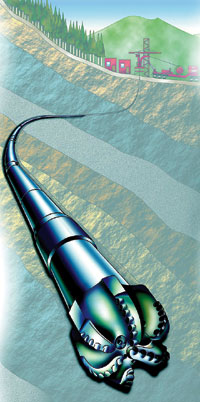 Technology from Europe: Technology from Europe:
United Kingdom
CT BHA for underbalanced drilling
 |
New BHA coiled tubing is half the length of other CTD assemblies.
|
|
Following several years in design, development and testing in controlled environments, Exeter-based Antech has a new coiled tubing bottomhole assembly, called Colt, which is ready for oil well field trials. Since 2002, a version of the BHA has been used by a Japanese company to drill a series of boreholes to identify potential waste-disposal sites. The tool successfully measured directional and drilling information while drilling. The company delivered the first custom system to Japan in 2002, and a second in 2004. Ongoing support continues with training and updates.
The new BHA was introduced, though not commercially, to the petroleum industry in 2001 and is designed for short-radius underbalance CT drilling for gas. The nitrogen foams and light fluids used during gas drilling don’t provide effective damping, so downhole tools are subjected to high levels of vibration and shocks from the drilling process. To withstand this punishment, the physical layout of the tool and its packaging is designed to resist drilling vibration.
Measuring just half of the length of conventional CTD assemblies, the tool is responsive, and can readily build angle. With this tool, drilling engineers are less constrained than with much longer CTD assemblies.
The tool provides precise control of drillbit orientation with the use of an electrically driven orienter that provides intermittent or continuous rotation. It is sized to allow rotation while drilling, avoiding lost time when changing direction. It also allows drilling built-up section and straight hole with the same tool.
To provide real-time feedback on downhole conditions, tool position and geological formation, the tool is equipped with sensors for wireline telemetry. These include pressure, and pressure-compensated weight-on-bit sensor, in addition to steering and gamma ray sensors. This information is continually transmitted to the surface.
According to Antech, there was a market gap for a cost-effective, reliable way to conduct short-radius, underbalance coiled tubing drilling for gas. The company is now on the brink of offering a viable solution. Once the new BHA is proven to perform in harsh drilling environments, gas drilling engineers will have a way to improve well productivity, says the company. The company is looking for appropriate wells in which to conduct field trails. It can run and maintain its own tools, but it needs an operator or service company to assist with drilling wells and the associated planning and preparation. 
|

 Technology from Europe:
Technology from Europe:

